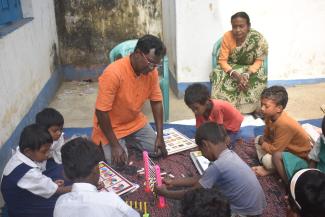Childhood
Indian schools’ historical neglect of poor communities
 Paresh Saren
Paresh Saren
Over 7 million people speak Santali in India, according to census data from 2011. The Santals are India’s third most populous Adivasi tribe. The Adivasis are the indigenous people of India.
The Santals are concentrated in seven states. Bangladesh also has a considerable Santal community.
Tribal people are often disadvantaged in Indian society. That tendency was confirmed by the 2011 Census. It showed that the literacy rate of Santals in the state of West Bengal was not quite 55 %. The state figure was a bit over 76 %, slightly above the national literacy rate of 73 %.
Even after independence, Indian governments tended to neglect education for poor communities. In the 1990s, for example, experts reckoned that only about half of the young generation that should be going to school was actually doing so. Some even argued that the neglect was intentional, as high-ranking policymakers feared the dissatisfaction marginalised communities might express if they fully understood what was keeping them down.
Things have changed, however. Quite likely, the UN’s Millennium Development Goals made a difference. They included targets for school attendance, and successive Indian governments were ashamed of how poorly their nation fared in international comparisons. Enrolment rates for primary and secondary schools have improved, with both boys and girls benefiting.
An important law
In 2009, the national parliament passed the Right to Education Act (RTE). It is the most important law regarding education in India and focuses on universal schooling for the age group 6 to 14 years. Pre-primary school education, however, still did not get the needed attention. In 2020, the National Education Policy acknowledged that good early childhood education (ECE) remained unavailable to masses of families, especially those from socio-economically disadvantaged backgrounds.
Adivasi communities speak languages of their own. Accordingly, they tend to be particularly disadvantaged when it comes to education. Motivated by the RTE, however, state governments have begun to set up schools that use Adivasi languages as the medium of instruction. There are therefore quite a few governmental schools that use Santali. They cater to students from classes 1 to 12. Educators point out that they are very important for promoting literacy and teaching youngsters the regional language properly. Children that cannot effectively communicate with teachers are very likely to drop out of school.
D+C/E+Z



